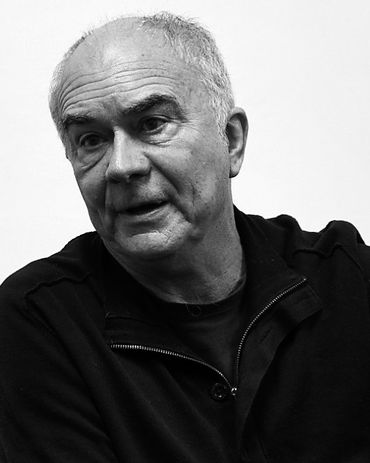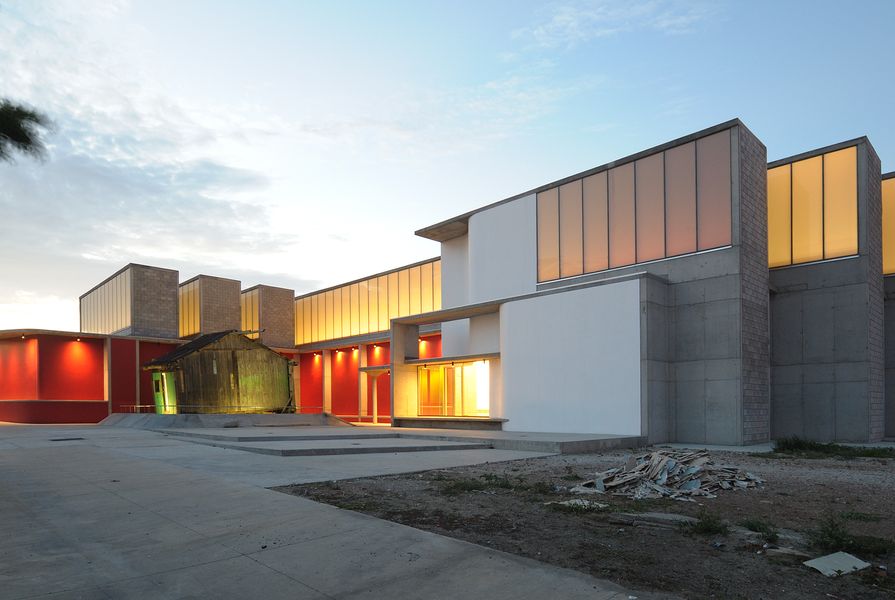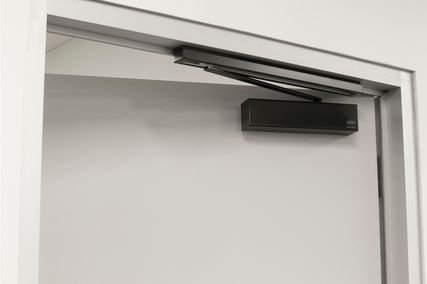Jo Noero formed his practice, Noero Architects, in 1984 Johannesburg. Now with offices in Cape Town and Port Elizabeth, today the practice has more than 200 buildings to its name, with a focus on museums, schools, art galleries, university buildings and social housing.
Warwick Mihaly: A central part of your work is the importance of quality buildings within disadvantaged contexts, and the possibility they present in influencing the surrounding built environment. How does this relate to your Red Location project in Port Elizabeth?

Jo Noero.
Image: Peter Bennetts
Jo Noero: I’ll tell you how it all started. Many years ago when I was teaching, I felt quite alienated from mainstream architectural practices in South Africa, and I was looking for somewhere to locate both my research and practice interests. The places that I was drawn to were the informal shack settlements on the periphery of the city. I figured at that time in the country, these were the only places where people acted with unfettered freedom in shaping their environment, even accounting for their extreme poverty. I have always held the idea that authentic culture grows from the bottom up: the people living in the shack settlements were outside government control and were just building for themselves, so I went and had a look to understand how they were building, and ended up spending two years researching the settlements while I was teaching.
Out of that experience grew an interest in taking the structural systems and materials that were in use in those areas, and formalizing them through my work. I hoped to show local people a connection with what they were already doing themselves. It shows great resilience and energy to build something from nothing, and by incorporating this spirit into my own buildings I was also showing respect to the people living in the neighbourhoods around them.
WM: You’ve talked about using packing crates from car factories in your projects – a material already being used in the shack settlements.
JN: Yes, the reading room at the Red Location library. It’s clad in the same timber people use on their shacks. We used it for the most important building in the project and neighbourhood –except we sanded it down, fixed it properly and varnished it.
Reading room at Red Location Library.
Image: Courtesy Noero Architects
WM: Do you know whether that more refined material is now used within vernacular construction techniques?
JN: I’m not sure. My sense is that people appreciate what I do, but I haven’t seen much evidence of whether they are actively trying to take those systems and develop them in the same way I have. The opposite does occur though: the timber cladding I used on the Red Location Library is now starting to find its way into rich houses, built by master craftsman in a shabby-chic style for a tremendous amount of money.
Really, I’m not even sure whether I want people to follow what I’m doing. It’s just me saying that I honour the people living in the shack settlements, I’m honoured to work in their space, so I look at how they build and work in the same kind of way. It’s simply that.
WM: The shabby-chic thing is curious. There was a bit of Twitter activity following your conference discussion.
JN: Good! Was it positive or negative?
WM: Both sides of the fence were represented. Somebody said they really like the shabby-chic look. Others suggested it’s a very dishonest architecture, cladding wealth in a surface of poverty.
JN: Exactly, it’s an architectural camouflage. It’s saying, “I’m rich but I identify myself with the poor, I’m a comrade in arms…”
WM: Is it dishonest then, or just a less sophisticated form of honouring the context?
JN: I think it’s a style, that’s all. Some stylists have got hold of the idea and suddenly shack-chic has become fashionable and people follow it. But the connection between the style and the people in the poorer parts of the city is usually lost in translation. I like to think that at the very least there is some residual subconscious sense of the discrepancy.
Neil Leach wrote about this process in his book, The Anaesthetics of Architecture (MIT Press 1999). He describes two things that happen in the world. The first is that the greater the flows of information, the smaller the knowledge base. This particularly affects students, who have a tendency to place predominance on the image over everything else, without understanding its context.
WM: Because the issue with the modern day is not that there’s not enough information, there’s too much.
JN: Yes, and I don’t think we’ve learnt how to filter it effectively yet. The second thing Leach describes in his book is that Capitalism depends upon novelty; it’s what sells things. Novelty is as much image-based as it is commodity-based, and architecture has fallen victim to that. We have to be novel; we have to produce new things. But the problem with new things is that once they are consumed they are no longer of use. So we abandon images as quickly as we consume them.
We have this lumbering machine called architecture which takes five or ten years to get a building from inception to completion, and it’s held victim to these lightning fast movements of novelty, images and consumption. I don’t think architects have done a good job of managing or understanding it, or trying to find ways of countering it through other means.
WM: That’s a fascinating idea. I’ve always thought that architects are largely opportunistic; we do the work that is offered to us. Flipping that status quo around and seeking work out is immensely difficult to do, particularly when we have to make a living off our labour.
JN: I get offered lots of houses, usually they’re McMansion briefs – 1,000 square metres on the beach, all cantilevered –and I just say no. Houses like these are unethical. I don’t think you need anything more than 150 square metres to live comfortably. We have limited space in the world and many people with nowhere to live at all, so how can you be given the right to waste resources? The two or three people who have agreed with that philosophy have been the clients for the two or three best houses I’ve ever done.
I don’t think we do enough of that, enough proselytising. We are so stripped of self-esteem or dignity as architects that we see ourselves as an industry there to serve the public. But the public kick us around and tell us what to do. They’re not prepared to take wise advice from us. I don’t understand why that should be the case.
Front exterior of House Sapieka.
Image: Courtesy Noero Architects
WM: In Australia, there are so many other voices competing for attention within the built environment, and most of them are focused on all the wrong things. Clients regularly have a real estate agent or builder mate whispering in their ear, saying, “You’ve got to do this because this is what the market wants.”
JN: Absolutely. But I think there are useful ways of dealing with that situation. When I was in Peru about six years ago, I spoke with a lot of architects practising in Lima. It’s a tough city, hit by civil war, but what a lot of the good architects do is build as well. And in Buenos Aires, the three- to four-storey, middle-class apartment buildings are all built by architects.
WM: Is that legislated or is it just how it works?
JN: No. It’s just how it works. What they do is they find groups of people online who are willing to put money together to build something. It’s an opportunity to get a tailor-made apartment, even if it’s very small, because you are talking face-to-face with the architect rather than having to buy something that some developer has made.
WM: So apartment buildings crowd-funded by the end users?
JN: Yes. Some of the best architects in Lima said to me they make money out of the building side of things. They build their own projects and the money they make is used to support them while they enter competitions. So they get the one good project to do, rather than running around after awful people doing shit that they don’t like.
My wife and I are starting to build speculative houses ourselves, little ones. I’ve worked for so many people who make money out of my efforts, I thought, why don’t I put my money in the bloody ground and build something myself? We have two houses that are coming out of the ground now. I think there are lots of new and different ways that we can imagine working as architects in the world.
But whatever strategies we put in place to survive have got to support the ideal of architecture. We can’t just want to become project managers, because project managers are about making money. I’m only interested in making good architecture, it’s what gives me pleasure, and to make a bit of money out of it as well if I can.
WM: Going back to the Red Location project. You talked at the conference about how long it has taken, but also how good architecture takes time to get right. For the design and construction of one project to be spread across a generation, I feel that maybe the building is not the only end product, that there’s something even more meaningful to be achieved. Is there value in such a lengthy process?
JN: Well, the project brief set up in the competition has changed over time. I’m still working on the project and it’s still seen as part of the competition, but it’s different from where we started. There was lots of community participation up front to formulate the competition brief, after which we built the museum. But then there was a hiatus when we started to talk to people again about the new buildings. There were also issues of funding and a change in local government, so it just took a long time to get things done.
It can be frustrating because the bureaucracy in South Africa works slowly, but having the luxury of a couple of years to work on a library is fantastic. I can design very fast, but then I can take it and show the community and adjust it if I need to. Buildings just get better when you have time to work on them, that’s all it is.
Red Location Art Gallery.
Image: Courtesy Noero Architects
WM: How important was the community consultation process?
JN: I’m not a great one for upfront community participation. People don’t know what they want. If you just ask, you’ll find that everyone wants a three-bedroom house with two cars on a nice site overlooking the ocean. I find the best way of getting people involved is to provoke. I make a proposition, present it and then kick it around. I think people feel much more comfortable with that as well. They don’t feel that they are being put on the line to make big decisions. It’s only through an interactive design process that you can reach some kind of consensus.
WM: So when you present the initial concept on a project, which I presume is already a fairly resolved building, does it change in response to the community commentary you receive?
JN: Yes, it does. Look, when I talk about participation, I mean talking to all the different groups who are involved in a building, from the local people who use it, to city officials, politicians, community representatives, the architects, library services, gallery services etc. So there are all these layers to the process and the design gets filtered through all of it. A project can take years to work its way through every group, and at every stage adjustments have got to be made.
That’s for me what community participation is. The common idea that you sit down with a group of people and they tell you how their grandmothers lived in the UK isn’t what community consultation is at all. You need to sit down with the people who are actually going to use your building, the workers and the visitors and the cleaners. Why should this be any different when we deal with poor people or rich people? People get strange ideas when you talk to a poor community, that the process is somehow special. But I don’t see any difference between talking to a community or a family or a business. It’s just briefing.
Red Location Museum.
Image: Courtesy Noero Architects
WM: One of the things I thought about when you were presenting was the earlier conference lecture by Beth Miller from Philadelphia’s Community Design Collaborative. I felt quite anxious when she was talking about architects working pro bono. There has been a lot of controversy in Australia recently about architects working for free when the whole profession is struggling to make a living.
JN: I never work pro bono, ever. I had a clear lesson on this when I first started working in Johannesburg. I did some work for the Anglican Church under Desmond Tutu. The first church I worked on I did for nothing. I thought that’s the thing to do when you work for really poor people, but all I got was trouble from everyone. I went to speak to Desmond and I said, “Look, I don’t know what the problem is, but these people don’t respect a thing I do.” And he asked, “Are you charging them fees? Make sure you charge them money.”
WM: People respect what they pay for.
JN: Absolutely. From that time onwards it was their money on the line and they listened to everything I had to say. We shouldn’t ever have to work for nothing. I believe strongly in the dignity of labour. It’s like these architects who have interns but pay them nothing. I find that insulting.
WM: That’s the controversy in Australia actually.
JN: Well, I think anyone who takes someone on without paying them should be deregistered as architects. It’s immoral and unethical. What you’re saying to that person is that the value of their labour is worth zero.
WM: Former president of the Victorian Chapter of the Australian Institute of Architects, Jon Clements, made an impressive speech on that recently. I also read that RIBA has established a protocol that removes an architect’s accreditation if he or she is found to be employing someone without pay.
JN: They did that in the US as well.
WM: It will be a challenge to see whether or not there is enough steel in the Australian profession to do the same thing.
JN: Look, I think the work Beth Miller does is great, but one of the things I’m interested in is the difference between architecture and social work. I think there’s a distinction between being a professional architect and maintaining active citizenship. I’m actively involved in my country, but I don’t believe that through my architecture I’m going to create political change. If I wanted to do that I’d join a political party and I’d go out there and change things. Architecture doesn’t work like that. So it’s about understanding the limitations of architecture. Once you understand what architecture can and can’t do, you can be much more effective as an architect.
When I went to the last [2012] Venice Biennale, the American exhibition was essentially social work. It was about helping people learn to grow vegetable gardens in their back yards. That’s not what I want to do as an architect. I think we’ve got to be a bit careful that the pendulum on social accountability doesn’t swing too far and we lose sight of everything. The best thing we can do is make purposeful space that’s beautiful, which is bloody difficult to do as it is.
You know, I don’t go and look at any buildings I’ve done, I really don’t. When I hand a building over to my clients, it’s theirs and they must do with it as they see fit. I’m not going to go and sniff around and find out what they’ve changed, it’s their right to do whatever they like. For God’s sake, knock a hole in the wall, change the front doors, change the roof, it’s your building, do with it what you want.
WM: Interesting. It’s an understanding that architecture involves the dignity of exchange.
JN: Obviously, the client has paid for it. There’s a famous essay by Adolf Loos called The Poor Little Rich Man, it’s exactly this criticism. This poor little rich man, he went to the architect who designed anything, and then whenever he wanted to change a painting in his house he would have to ring up the architect to get his permission, and to get his advice. Is that what architecture is? That’s not architecture; it’s something else, control beyond any reasonable limits.
Making 2014 was presented by Australian Institute of Architects.




























